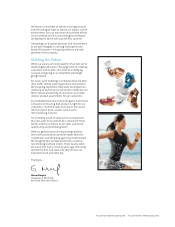The Gap 2008 Annual Report Download - page 21
Download and view the complete annual report
Please find page 21 of the 2008 The Gap annual report below. You can navigate through the pages in the report by either clicking on the pages listed below, or by using the keyword search tool below to find specific information within the annual report.We must successfully gauge fashion trends and changing consumer preferences to succeed.
Our success is largely dependent upon our ability to gauge the fashion tastes of our customers and to provide
merchandise that satisfies customer demand in a timely manner. The global specialty retail business fluctuates
according to changes in consumer preferences dictated, in part, by fashion and season. To the extent we misjudge
the market for our merchandise or the products suitable for local markets, our sales will be adversely affected and
the markdowns required to move the resulting excess inventory will adversely affect our operating results. Some of
our past product offerings have not been well received by our broad and diverse customer base. Merchandise
misjudgments could have a material adverse effect on our operating results.
Our ability to anticipate and effectively respond to changing fashion trends depends in part on our ability to attract
and retain key personnel in our design, merchandising, marketing, and other functions. Competition for this
personnel is intense, and we cannot be sure that we will be able to attract and retain a sufficient number of
qualified personnel in future periods.
Fluctuations in the global specialty retail business especially affect the inventory owned by apparel retailers, since
merchandise usually must be ordered well in advance of the season and frequently before fashion trends are
evidenced by customer purchases. In addition, the cyclical nature of the global specialty retail business requires us
to carry a significant amount of inventory, especially prior to the peak holiday selling season when we build up our
inventory levels. We must enter into contracts for the purchase and manufacture of merchandise well in advance
of the applicable selling season. As a result, we are vulnerable to demand and pricing shifts and to suboptimal
selection and timing of merchandise purchases. In the past, we have not always predicted our customers’
preferences and acceptance levels of our fashion items with accuracy. In addition, lead times for many of our
purchases are long, which may make it more difficult for us to respond rapidly to new or changing fashion trends
or consumer acceptance for our products. If sales do not meet expectations, too much inventory may cause
excessive markdowns and, therefore, lower than planned margins.
We experience fluctuations in our comparable store sales and margins.
Our success depends, in part, upon our ability to improve sales. A variety of factors affect comparable store sales,
including fashion trends, competition, current economic conditions, the timing of release of new merchandise and
promotional events, changes in our merchandise mix, the success of marketing programs, and weather conditions.
These factors may cause our comparable store sales results to differ materially from prior periods and from
expectations. Our comparable store sales have fluctuated significantly in the past on an annual, quarterly and
monthly basis. More recently, over the past three years, our comparable store sales figures have been negative year
over year as demonstrated by a decrease of seven percent in fiscal 2006, a decrease of four percent in fiscal 2007,
and a decrease of twelve percent in fiscal 2008. Over the past five years, our reported gross margins have ranged
from a high of 39 percent in fiscal 2004 to a low of 36 percent in fiscal 2006. In addition, over the past five years,
our reported operating margins have ranged from a high of twelve percent in fiscal 2004 to a low of eight percent
in fiscal 2006.
Our ability to deliver strong comparable store sales results and margins depends, in large part, on accurately
forecasting demand and fashion trends, selecting effective marketing techniques, providing an appropriate mix of
merchandise for our broad and diverse customer base, managing inventory effectively, using effective pricing
strategies, and optimizing store performance. Failure to meet the expectations of investors, security analysts, or
credit rating agencies in one or more future periods could reduce the market price of our common stock and cause
our credit ratings to decline.
Changes in our credit profile or further deterioration in market conditions may limit our access to the
capital markets.
Although we believe that our existing cash and cash equivalents combined with future cash flow from our
operations will be adequate to satisfy our capital needs for the foreseeable future, we may require additional cash
for unexpected contingencies.
9
























